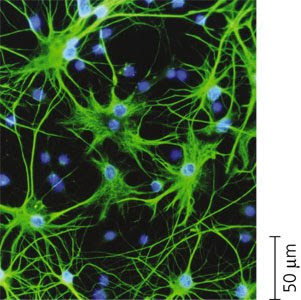 |
| Astrocytes |
It's going to take a lot of research, duplicated, peer-reviewed, and sanctified, thrice, by a Comprehensive and Integral Ad Hoc Committee Assembled by the Creator of the Universe, for me to get on the Ketamine Bandwagon.
It could happen.
Today's offering comes from a group of scientists from the K. K. Leung Brain Research Centre of the Fourth Military Medical University in Xi’an, China, and is published in Molecular Pain. The authors come from the Departments of Anesthesiology and Anatomy.
The folks hailing from Anesthesiology are further specialized as "stomatologists." "Ewww!" was my first thought, closely followed by curiosity about CRPS of one's stoma... but it turns out that stomatology is the study of the mouth and its diseases: dentistry, in other words! I guess an anesthesiologist/stomatologist represents -- in Western formulations -- someone with a DDS who has done post-graduate work in anesthesiology. What it means in the Chinese context, I dunno. Perhaps it includes acupuncture.
That there is a décalage between Western Dentistry and Chinese Stomatology is clear: For instance, like the American Dental Association, the Chinese Stomalogical Association declared that fluoride toothpaste helps prevent tooth decay... but C.S.A. did it in 2007. I guess the actual availability of fluoridation plays a big part in that evolution, and further realize that the issue of fluoridation is not as clear cut to some as it is to me. If you believe that fluoride causes cancer, then the topic of fluoride in your communal water supply is not a lighthearted topic. [Okay, moving right along... don't wanna get lost... too late? Is it too late?]
Rather quickly, I am wondering about the quality of translation in this work. The current PDF version at Molecular Pain is provisional, with a promise of a fully formatted/full text version to be available soon. I hope that can include scrutiny of translation from Chinese to English. For instance, I am sure this sentence can be improved upon:
However, the present clinical therapeutics is still just concerning about neuronal participation.
And just because, I would like one of the authors to expound upon this:
Combined administration obviously relieved mechanical allodynia in a quick and stable manner. [How?! How did they know?! I mean, my assumption is that we're talking lab rats here... Was it that deep sigh of relief? The fading furrows on the brow? That certain sassy swish to the tail?]
Hmmm? The claim? The object of the study? Jeez, but You Readers are demanding. Is that a Burgeoning Sense of Entitlement rearing its ugly little head?
Combining ketamine with astrocytic inhibitor as a potential analgesic strategy for neuropathic pain
Molecular Pain 2010, 6:50 doi:10.1186/1744-8069-6-50
Published: 6 September 2010
ABSTRACT
Background: Neuropathic pain is an intractable clinical problem. Intrathecal ketamine, a
noncompetitive N-methyl-D-aspartate receptor (NMDAR) antagonist, is reported to be useful for
treating neuropathic pain in clinic by inhibiting the activity of spinal neurons. Nevertheless,
emerging studies have disclosed that spinal astrocytes played a critical role in the initiation and
maintenance of neuropathic pain. However, the present clinical therapeutics is still just concerning
about neuronal participation. Therefore, the present study is to validate the coadministration
effects of a neuronal noncompetitive N-methyl-D-aspartate receptor (NMDAR) antagonist
ketamine and astrocytic cytotoxin L-α-aminoadipate (LAA) on spinal nerve ligation
(SNL)-induced neuropathic pain.
Results: Intrathecal ketamine (10, 100, 1000 μg/kg) or LAA (10, 50, 100 nmol) alleviated
SNL-induced mechanical allodynia in a dose-dependent manner respectively. Phosphorylated NR1
(pNR1) or glial fibrillary acidic protein (GFAP) expression was down-regulated by intrathecal
ketamine (100, 1000 μg/kg) or LAA (50, 100 nmol) respectively. The combination of ketamine
(100 μg/kg) with LAA (50 nmol) showed superadditive effects on neuropathic pain compared with
that of intrathecal administration of either ketamine or LAA alone. Combined administration
obviously relieved mechanical allodynia in a quick and stable manner. Moreover, down-regulation
of pNR1 and GFAP expression were also enhanced by drugs coadministration.
Conclusions: These results suggest that combining NMDAR antagonist ketamine with an
astrocytic inhibitor or cytotoxin, which is suitable for clinical use once synthesized, might be a
potential strategy for clinical management of neuropathic pain.
Direct Correspondance to:
Dr. Li-Xian Xu at
Department of Anesthesiology, School of Stomatology
Fourth Military Medical University, Xi’an, 710032, China
Tel: 86-29-84776115 Fax: 86-29-84776115 E-mail: kqmzk@126.com
Dr. Sheng-Xi Wu at
Department of Anatomy, Histology and embryology; K.K. Leung Brain Research Centre, Fourth
Military Medical University, Xi’an 710032, China
Tel: 86-29-84773074 E-mail: shengxi@fmmu.edu.cn
Dr. Yun-Qing Li at
Department of Anatomy, histology and embryology, K. K. Leung Brain Research Centre, Fourth
Military Medical University, Xi’an, 710032, China
Tel: 86-29-84774501 E-mail: deptanat@fmmu.edu.cn
ABOUT MOLECULAR PAIN:
Molecular Pain is an open access, peer-reviewed, online journal that encompasses pain research at the cellular, subcellular and molecularlevels.
Molecular pain is a growing research field that represents an advanced step from conventional pain research, addressing physiological and pathological pain at the cellular, subcellular and molecular levels.
Molecular pain research integrates pain research with molecular biology, genomics, proteomics, modern electrophysiology and neurobiology. The field of molecular pain research has great promise for the identification of highly specific and effective targets for the treatment of intractable pain.
No comments:
Post a Comment
The Haddock Corporation's newest dictate: Anonymous comments are no longer allowed. It is easy enough to register and just takes a moment. We look forward to hearing from you non-bots and non-spammers!